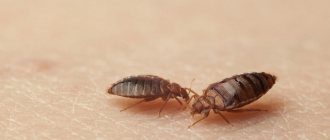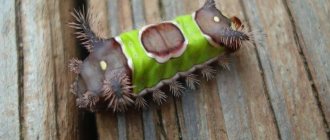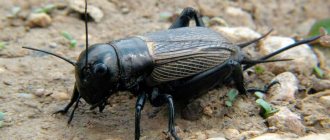There is no point in being offended by this: Mother Nature already came up with everything long ago before us. Bacteria, as it turned out, have functional wheels (people only got around to them 7 thousand years ago), ants “invented” agriculture, spotted salamanders learned to use solar panels (though only at the embryonic stage). It's even funnier that when it comes to horror and trash, nature is even more ahead of us. Lovecraft dreamed up his “indescribable beasts” by looking at a banal plate of seafood. Clive Barker wrote The Midnight Meat Train and The Skin of Fathers while thinking about the behavior of insects. Everything is clear about the creators of “Sharknado” - they didn’t bother at all.
So we can hardly come up with anything more frightening than the creatures that exist in nature. Think of the cordyceps zombie fungus, or the killer bug that vomits into the insides of its victims, eats them, and then makes camouflage out of their dead bodies.
Assassin beetles and their entertaining way of killing
In Russian these beetles are called “predators”. Recently, thanks to translated articles on the Internet, they have acquired the nickname “killer beetles.” But in English they have the coolest and most accurate name - “assassins-bugs”. They actually sneak up on the victim (other insects) from the back and kill it by pouncing and piercing it with a kind of sword - the rostrum.
The rostrum is both a sharpened weapon and the proboscis of an assassin beetle. Having made a wound in the victim’s body, he begins to literally vomit into her insides. The juice of the killer beetle contains paralytic poison and enzymes that decompose the insides of the captured insect. It seems that it remains in consciousness for some time, while our hero sucks out the insides as if with a straw. Pretty brutal!
But among the 7,000 species of predators, there are especially delightful characters - Acanthaspis petax. This type of assassin bug not only kills its victims in the manner described, but also has one hell of a cool camouflage. The assassin beetle lives in Malaysia and East Africa, which is why there was even an assumption that they were brought from Southeast Asia by settlers on rafts. So here's another fun fact for you - the ancestors of modern Malagasy sailed to Africa from Asia along the coast of the Indian Ocean thousands of kilometers away, although it is not very clear why.
Poisonous killer beetle
According to scientists who have studied the fossil record of insects, the wide diversity of the insect world is associated with a large number of new species constantly appearing. One of these is a species of beetle recently discovered by scientists, which is capable of killing everything around with its poison, including large animals and people.
These insects are so tiny in size that they are difficult to see with the naked eye. There are cases where victims of beetles received fatal bites in a situation in which they accidentally stepped on them with their feet or leaned on them with their palms.
The poison released by the insect instantly penetrates through the wound under the skin, provoking the rapid development of an irreversible destructive process. Scientists have not yet developed an antidote to the toxin.
The most dangerous killer beetle has been discovered in India. The nature of the origin of tiny, but incredibly dangerous creatures has not yet been clarified. According to one version, insects are the “fruits” of prohibited experiments in the creation of biological weapons or “waste material” of unsuccessful laboratory research.
At the moment, the killer beetles are localized within the South Asian country. It is difficult to determine how quickly they will spread around the world. For residents of India, the situation is aggravated by the factor of overpopulation. Moreover, the majority of people are below the poverty line. People often do not have any shoes and walk on the ground barefoot, risking “running into” a dangerous enemy.
Scientists are now faced with two tasks: to develop an antidote and to prevent the expansion of the range of deadly insects.
Corpse camouflage
Having eaten the entrails of captured ants or termites, Acanthaspis petax throws their corpses onto its back. That, in turn, secretes a special sticky secretion, so that bodies stick to it quite well. In total, the killer beetle can attach up to 20 ant exoskeletons to itself. As a result, he begins to look like a gargantuan pile of stuck together ants. Well, or like a walking cemetery of insects.
Entomologist Christiane Weiruch from the University of California, who studied assassin beetles, says that for all the time they have been observing them, scientists have not understood exactly how these insects manage to carefully cover themselves with other people's carcasses. Assassin beetles have legs that are too short to properly accommodate ant bodies on their backs. Perhaps Acanthaspis petax simply throws them into the air, trying to catch them with its back - in this case, we can say that insects also have sports games. Perhaps he simply lies on the bodies of the eaten victims, like a dog who found the corpse of a crow in the park.
In any case, we at least understand why the beetle needs such camouflage. In 2007, entomologists from New Zealand's University of Canterbury conducted an experiment. They placed an assassin beetle and its main natural enemy, a spider, in a flask. It turned out that beetles with camouflage of ant corpses were attacked 10 times less often. Apparently, the spiders either mistake this lump for a crowd of ants that can fight back, or they simply do not understand what exactly is in front of them. It is possible that the assassin beetle in its armor looks like some kind of abstract figure to predators. With the second main enemies of Acanthaspis petax, geckos, everything is even simpler - a pile of empty exoskeletons predictably seems inedible to them, and they, as a rule, simply spit it out.
Spider experiment
To find out why beetles make these “gentle” touches, scientists decided to conduct an experiment. They brought to the laboratory 30 individuals of Pholcus phalangioides, which are spiders no larger than one centimeter in size. Scientists placed the tiny creatures on webs and began tapping some of their bodies with dog hair to imitate the gentle touch of killer bugs. After this, they knocked on a tuning fork installed in the corner of the web, the vibrations of which imitated the movements of the trapped victim.
Spider Pholcus phalangioides
It turned out that after tapping, the spiders responded to vibrations much more calmly. In some cases, they completely ignored the tuning fork, while other individuals ran to look at the prey. The researchers concluded that small taps seem to spiders to be touched by their relatives or potential partners, so they calm down. According to one of the authors of the scientific work, Anne Wignall, this feature prevents spiders from accidentally eating their relatives. Their worst enemies, killer beetles, actively take advantage of this.
Stenolemus assassin beetles are also not particularly large
According to zoologist Ondrej Michalek, who was not involved in the scientific work, the conclusions of his colleagues are fully justified. As an expert on invertebrate creatures, he noted that many spiders avoid cannibalism by relying on tactile signals. Over the years, enemies of spiders have been able to notice this and take advantage of it. In the future, the authors of the scientific work want to find out exactly how many taps need to be made on the spider’s body in order to calm it down. After all, if you make them too few or too many, an arthropod predator may sense something is wrong and defend itself from its rival. Scientists also want to find out what types of spiders this trick can be used against.
Life hack from the assassin beetle: how to quickly get an endless source of food
The same Christiana Weiruch talks about how the Assassin Beetle camouflage turns out to be even more useful. One of her colleagues working in East Africa witnessed Acanthaspis petax using a sneaky but ingenious trick while hunting termites.
The fact is that termites have so-called “social immunity”. They instinctively try to get rid of the corpses of their fellow tribesmen, throwing them outside the colony. The Assassin Beetle takes advantage of this. He stands in a passage in a termite mound, catches one of its inhabitants, “drinks him dry” and leaves his body hanging from his rostrum as bait. Other termites, obeying the call of social immunity, run to remove this fresh corpse and soon take its place. There is a known case where one beetle ended up eating 48 termites - one after another, like on a conveyor belt.
killer beetle
Kissing bugs
The so-called kissing bugs also pose a great danger. They are nocturnal. Killer beetles got their name from their predilection for stinging people on the mucous membranes of their lips and eyelids while they are asleep. Coleopteran predators are attracted by the carbon dioxide released during human respiration. Infection occurs at the moment of blood sucking and at the stage when the victim instinctively rubs the bite site, rubbing in the feces left by the parasites at the “crime scene.”
Within a couple of weeks after infection, a person’s eyelids swell, fever appears and acute heart failure develops, in most cases leading to death.
Parasitic protists live in subtropics and tropical regions.
The bite of trypanosoma cruzi causes people to develop Chagas disease, which is difficult to treat. According to medical estimates, today about 7-8 million people suffer from tropical parasitic disease. These are mainly residents of South and Central America, as well as Mexico. 12.5 thousand people die from this disease every year.
The most surprising thing is that, despite such a colossal scale, the WHO still ranks Chagas disease as one of the ten most “neglected” tropical diseases. There is still no vaccine against this common disease.
3
Giant stick insects
0
These are the longest insects in the world, some females exceed 14 centimeters in length. They live mainly in warm climate zones and outwardly practically merge with the surrounding world, especially if they are in the forest. Depending on the species, these insects use vomit, feces or blood as self-defense.
×
Photos and descriptions of poisonous insects in Russia
There are no deadly insects on the level of spiders in Russia, but there are stinging and blister beetles. Those that sting include:
- bees;
- bumblebees;
- wasps;
- common hornet;
- Asian huge hornet.
Unlike bloodsuckers, these insects do not care about humans, although their bite is truly poisonous and causes severe pain. Serious consequences after bites of these insects occur in people who are allergic to the poison.
- Bee. A bee sting is painful. The insect is poisonous. But bees bite only to protect themselves or the hive. To avoid the bee's attention, it is enough not to touch it.
- Bumblebee. The same applies to the bumblebee. The sting of a bumblebee and a common hornet is approximately equal in pain. But from a bumblebee, local irritation of soft tissues is less than from a hornet.
- Wasp. Likes to settle near human habitation. More aggressive than a bee. And more annoying. But the sting of a wasp is reusable, and a person receives less poison than from a bee.
- Common hornet. Hornets belong to the wasp family and are the largest representatives among these insects. The size of the insect is 3.5 cm, which makes its bite quite dangerous to humans. But this same wasp is less aggressive than its smaller relatives. By hunting other insects, the hornet brings more benefit than its bite can harm. The common hornet is widespread throughout the European part of Eurasia. It is also found among insects in Western Siberia and the Urals.
- Asian hornet. This insect is truly dangerous to humans, not only because of its size. The Asian giant hornet also has highly toxic poison. The largest wasp in the world reaches a length of 5 cm. The length of its sting is 6 mm. When bitten, the sting penetrates deep into the soft tissue, and the hornet injects a large dose of poison. A hornet cannot kill with one bite, but if a person is stung by several insects at the same time, the probability of death becomes very high.
Stinging insects
On a note!
For a person with allergies, one Asian hornet sting will be enough.
Great killer Konstantin Zhukov
In the entire Great Patriotic War there was no figure more powerful, significant, and SUBSEQUENTLY revered than Georgy Konstantinovich Zhukov. The cult of Zhukov was systematically instilled; the infallibility and genius of the wisest strategist of all times and peoples was never questioned. Statues that were previously gods fell, shrines were trampled, yesterday’s idols were cursed. The cults of Khrushchev, Brezhnev, Andropov, Chernenko, Gorbachev have melted away, as if they never happened, and the cult of Zhukov, lo and behold, continues to cast the sparkling bronze of a polished cleft chin.
Anyone who tries to throw a well-deserved lump of dirt into the face of this statue immediately runs into a barrage of criticism, contempt and boycott from the descendants of Soviet citizens who died in the war, grateful to Zhukov. But isn’t Zhukov the MAIN culprit for the unjustified, incomprehensible number of victims of the Great Patriotic War?
Beria, begging for his life from the new party leaders in 1953, sent them notes. In one of them, he reminded Zhukov how he saved him from imminent execution in July 1941. This refers to the episode with the encirclement of the Western Front. For the first encirclement, Army General Pavlov was shot, for the second it was necessary to put the Chief of the General Staff, that is, Georgy Konstantinovich Zhukov, against the wall.
To be objective, it was not Pavlov who should have been shot (and he was shot, and a hundred more people were shot), but the same Zhukov. Since Pavlov did not invent instructions himself, but received them from headquarters. The second time, Stalin did not look for scapegoats, and took the “brilliant commander” by the collar. He was removed from the post of Chief of the General Staff, and would inevitably have been shot if not for Beria, whom the wisest of the wise and the most objective of all objective in his incredibly boring works, republished a hundred times and supplemented to suit the situation, subsequently poured shit on him.
By the way, about works that are reprinted a hundred times. In his magnificent book “I Take My Words Back,” Viktor Suvorov, aka Vladimir Rezun, superbly demonstrated how the point of view of the “principled and inflexible” changed depending on the party line. Either he licks Brezhnev, then Khrushchev, then Golikov is a mug, then Kuznetsov is a coward. Georgy Konstantinovich invariably extols himself.
He wasn’t afraid of Stalin, and he foresaw and predicted the events of June 1941. He foresaw, but did nothing. Who is more of a scoundrel and scoundrel - a fool who does not understand the collapse that inaction will lead to, or a genius who knows that millions will die and does nothing? Then, in the little books of “his own”, on which a whole bunch of writers worked, Zhukov will tell schoolchildren about his prophetic gift. Schoolchildren will marvel at the wisdom of a genius. It's good to be wise and insightful years later. But didn’t Zhukov personally sign the codes sent to both Pavlov and the commander of the Baltic Military District?
“You, without the sanction of the People's Commissar, gave an order for air defense to introduce regulation No. 2... your order causes various rumors and irritates the public. I demand that the order given be immediately cancelled, and that an explanation be given for the report to the People's Commissar. Zhukov".
The Baltic Special Military District dared to begin preparations to repel the inevitable strike, and Zhukov was right there - “cancel this order!” The ciphergram was signed on June 18, four days before the start of the invasion. Beria forced the brilliant commander to sign at gunpoint? Subsequently, the principled and wise military leader will explain this and his other criminal orders very simply. I was afraid, they say. It was scary. On August 13, 1966, speaking at the editorial office of the Military Historical Journal, Georgy Konstantinovich opened up:
“Who wants to lay their head down? Let’s say I, Zhukov, feeling the danger looming over the country, give the order: “Deploy.” They report to Stalin. On what basis? Based on danger. Come on, Beria, take him to your basement.”
It could have been easier to justify - “I’m a coward, I was afraid that they would make a hole in my skin, so let the country die, and I’ll watch it.”
Stalin allowed the defeat of 1941. But who was Zhukov at the time of this defeat? In 1941, the Red Army was crushed, defeated, 4 million soldiers and officers were captured, and about 85% of industrial capacity was captured. And this despite the fact that the offensive units of the Wehrmacht numbered 1.5-2 million soldiers, and in terms of the number of aircraft and tanks, Germany was five to six times inferior to the USSR. Who, if not Zhukov, is to blame for the disaster of the first year of the war? Who else but him should the millions of orphans, widows, and mothers who lost their sons in this meat grinder curse? They accused Timoshenko, Beria, Merkulov, accused Golikov and Kuznetsov, and spat on Pavlov’s corpse. But Zhukov seemed to have nothing to do with it. He, the head of the General Staff, was not to blame for the horror of the first months of the war.
What is Rezun-Suvorov accused of? The fact that he DARE to call a spade a spade. A man who sacrifices armies to save his own skin is a coward and a criminal. A person who gives orders for the execution of peaceful demonstrations (in March 1956 - in Trilisi, in November of the same year - in Hungary) is a war criminal who deserves execution and contempt. Rezun justified it with documents: Zhukov is not only a coward and a criminal, he is a liar and a braggart, he is an unprincipled sycophant who does not have his own opinion, an opportunist and an inventor. For this, Rezuna ata, and the portraits of “St. George the Victorious” will again be dragged through the streets on May 9th.
Rezun dared to mention the code number 4976 in the book. For this, Rezun is shamed and reprimanded. And Zhukov, according to tradition, is given national veneration. Here is the content of the document:
“Explain to all personnel that all families of those who surrendered to the enemy will be shot, and upon returning from captivity they will also be shot.”
These words could be engraved on the monument to the great commander. In gold letters so that they shine so that all fans can see them. Illiterate, having not read even two books in his life (during a search at the commander’s dacha, kilometers of fabrics, hundreds of carpets and tons of crystal, but not a single book were revealed), and proud of the fact that he “didn’t graduate from academia,” this mediocrity and murderer was mistakenly included in the list military leaders who defeated fascism.
It has nothing to do with the Battle of Stalingrad, the Korsun-Shevchenko operation, or the Battle of Kursk. He cowardly demanded to leave Moscow (and Stalin made it clear to him that this would not happen), he gave orders for the execution of his own soldiers both during and before the war (at Khalkhin Gol in 1939, 600 people were shot in 104 days), without hesitation he put him in camps (remember Kushchev, later a colonel general, a war hero), and sincerely considered the soldiers to be cannon fodder. The bloody crimes of this monster will still be judged, and busts with prominent chins will still be thrown in disgust into the gutters. They will also remember the battleship Novorossiysk, which, according to the idiotic official version, was blown up by the mythical “combat swimmers of Prince Borghese”, they will remember the hundreds of sailor boys who died a terrible death because of Zhukov’s hatred of Admiral Kuznetsov, they will remember the St. Petersburg executions of September 1941 .
Someday, the descendants of millions of heroes of the Patriotic War will erase the name of this “commander” from the books about victory, because this type has a very indirect relationship with the great victory of our people. But on May 9, Victory Day, portraits of a murderer, polygamist and maniac will be carried through the streets of liberated cities by the grandchildren and great-grandchildren of those whom the greatest genius of military affairs, through his feeble-mindedness and cowardice, turned into humus...
Dangerous bugs
The attitude towards Coleoptera is usually not serious. They may be feared like any other insect, but no one thinks that a beetle can be truly dangerous. Among this group there are poisonous or simply painfully biting ones.
Blister beetles
The name “blisters” speaks for itself. These are poisonous beetles that protect themselves with caustic mucus. Liquid is released through the pores of the body if the beetle is disturbed. The mucus eats away at the skin, leaving abscesses in the area. Several species of blister beetles live on the territory of Russia:
- Schaeffer's blister;
- red-headed blister;
- black-headed spandex;
- ash spandex (Spanish fly);
- T-shirt purple/blue.
On a note!
The toxicity of ash spanka is used for medicinal purposes. Various preparations called “Spanish fly” are prepared from it.
Blister beetles
Kazakhstanis are being frightened by a scary killer bug via WhatsApp
“Be extremely careful and warn your children!”, “Death within two hours”... I, as a respectable mother, am a member of several parent WhatsApp chats, and every time someone sends a photo of a frightening-looking insect with threatening warnings. At this point you can’t help but think: maybe all sorts of karakurts, tsetse flies and ticks really have a serious competitor?
A search on the World Wide Web produced several dozen links to the required news. All of them are dated last fall. As the unnamed authors claim, the new insect appeared in India and is most likely the product of a scientific experiment that got out of control. And supposedly there are already victims.
“If you ever see this insect, do not try to kill it with your bare hands or even touch it. Upon contact, a person becomes infected with a virus that quickly affects the entire body. This horror was first noticed in India. Share this information with your family and friends. Let children be especially careful, because they love to pick up all sorts of bugs and insects ,” warns one of the news aggregators.
But the search for a photo of an insect unknown to science refers to images of a water bug that has been fully studied by entomologists. As it turned out, the supposed capsules with poison on the back of an unknown animal are carried by the young animals of its giant water bug, which actually lives in India, for greater safety.
– A person believes in what he wants. Anyone who has critical thinking and a high level of intelligence usually checks such controversial news without difficulty, but, unfortunately, not all of them. Some people, it seems, generally enjoy frightening others with such fakes (fakes. - Ed. ), - comments the director of the Legal Media Center Public Fund, Diana OKREMOVA, .
She herself often organizes seminars for young journalists, where she explains in detail how to spot fake news. But it seems that with the development of the Internet, this kind of educational program must be carried out for the entire population.
– Any publication must give a specific answer to three questions: what, where, when? With newsletters on social networks, everything is a little more complicated, because the information is compressed into one or two sentences. But there still needs to be some specifics that can be verified, says the media expert.
Diana Okremova advises to be especially careful about publications that begin with the words: “Attention!”, “Very important!” and ending with the words: “Maximum repost.” Often such loud calls serve one purpose: to attract the user’s attention to something insignificant and distract from something important.
Astana











